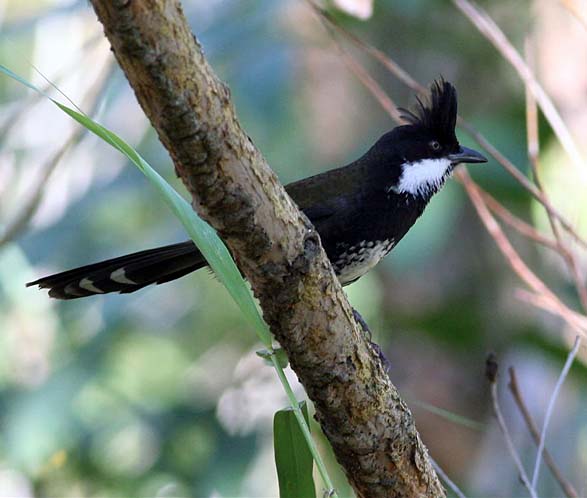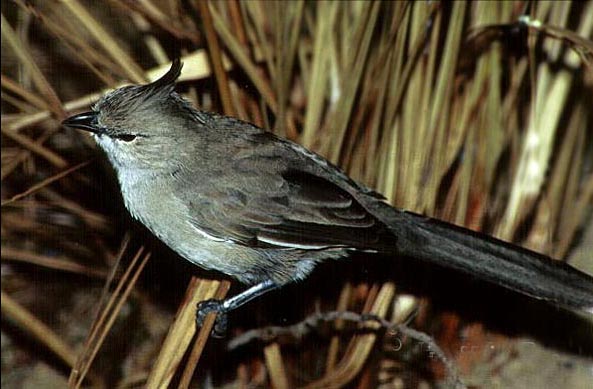| |
WHIPBIRDS & ALLIES Psophodidae
- 9 species worldwide
- DR personal total: 3 species (33%), 0 photos
 The
full English name of this family could be: Whipbirds, Wedgebills and
Jewel-Babblers
(Dickinson 2003). It is a small family of secretive, mostly
forest-dwelling
birds of Australasia. Traditionally,
these
were included with logrunners and quail-thrushes in the family
Orthonychidae.
Then Sibley & Ahlquist (1990) split out the logrunners as a
family [see Orthonychidae page]. But the quail-thrushes of Australia still remained with these
other
species, and for a while they were known as the Cinclosomatidae (Sibley
& Ahlquist 1990, Sibley & Monroe 1990). Recent DNA analysis,
however,
also splits out the quail-thrushes as a distinct family (Dickinson 2003,
Barker et al. 2004; see Cinclosomatidae page). So with the quail-thrushes taking the family name with them, a
new
name was needed again. Initially, the oldest name (and thus the
priority) belonged to
Rail-Babbler Eupetes macrocerus; the family was briefly
named the
Eupetidae. But the rail-babbler proved so distinctive that it deserved
family status on its own (Dickinson
2003, Jønsson et al. 2007; see Eupetidae page). The rail-babbler's closest
relatives proved to be the rockjumpers of Africa [Jønsson et al. 2007]. So the rail-babbler became
the Eupetidae, leaving the Whipbirds, Wedgebills and
Jewel-Babblers as the Psophodidae. Confused? Welcome to the wide, new,
wonderful world of biochemical taxonomy! The
full English name of this family could be: Whipbirds, Wedgebills and
Jewel-Babblers
(Dickinson 2003). It is a small family of secretive, mostly
forest-dwelling
birds of Australasia. Traditionally,
these
were included with logrunners and quail-thrushes in the family
Orthonychidae.
Then Sibley & Ahlquist (1990) split out the logrunners as a
family [see Orthonychidae page]. But the quail-thrushes of Australia still remained with these
other
species, and for a while they were known as the Cinclosomatidae (Sibley
& Ahlquist 1990, Sibley & Monroe 1990). Recent DNA analysis,
however,
also splits out the quail-thrushes as a distinct family (Dickinson 2003,
Barker et al. 2004; see Cinclosomatidae page). So with the quail-thrushes taking the family name with them, a
new
name was needed again. Initially, the oldest name (and thus the
priority) belonged to
Rail-Babbler Eupetes macrocerus; the family was briefly
named the
Eupetidae. But the rail-babbler proved so distinctive that it deserved
family status on its own (Dickinson
2003, Jønsson et al. 2007; see Eupetidae page). The rail-babbler's closest
relatives proved to be the rockjumpers of Africa [Jønsson et al. 2007]. So the rail-babbler became
the Eupetidae, leaving the Whipbirds, Wedgebills and
Jewel-Babblers as the Psophodidae. Confused? Welcome to the wide, new,
wonderful world of biochemical taxonomy!
Seeing any of the whipbirds, wedgebills, and jewel-babblers
can be a
challenge to the observer. The whipbirds of Australia have loud
distinctive
vocalizations that announce their presence in the understory. That of
the
male Eastern Whipbird ends with a note like the crack of a whip, to
which
the female immediately answers 'chew-chew' (Morcombe 2000). Seeing one
is another matter. I remember hearing them all the time around
Cassowary
House in northeast Queensland but seeing them only with difficulty. I
have
no photos myself of this family, so I asked my friend Murray Lord to
see
if any of his Aussie friends had photos. He tried but didn't come up
with
anything so finally he took things into his own hands, trundled his new
camera down to the back of his Sydney 'garden,' and photographed an Eastern
Whipbird himself (left or above). It turns out to be a great shot
of
this jay-sized bird (© Murray Lord).
|
 Dickinson
(2003) lists two additional species of whipbird in Australia — Western Psophodes
nigrogularis and Mallee P. leucogaster (this latter taxon is a relatively
new
split) — and another from west-central New Guinea, Papuan Whipbird Androphobus
viridis. These have distinctive voices but not the 'whip-crack'
note.
Then there are the two wedgebills of the mulga zones of the Australian
interior. Each is named for a characteristic vocalization: the Chiming
Wedgebill (right) is shown here in a fine photo by Hans
&
Judy Beste. It, like all the wedgebills and whipbirds, has a little
crest. The final wedgebill is the Chirruping P. cristatus. Dickinson
(2003) lists two additional species of whipbird in Australia — Western Psophodes
nigrogularis and Mallee P. leucogaster (this latter taxon is a relatively
new
split) — and another from west-central New Guinea, Papuan Whipbird Androphobus
viridis. These have distinctive voices but not the 'whip-crack'
note.
Then there are the two wedgebills of the mulga zones of the Australian
interior. Each is named for a characteristic vocalization: the Chiming
Wedgebill (right) is shown here in a fine photo by Hans
&
Judy Beste. It, like all the wedgebills and whipbirds, has a little
crest. The final wedgebill is the Chirruping P. cristatus.
The three species of jewel-babblers Ptilorrhoa replace
each other
elevationally in the rain-forests of New Guinea. Each is a spectacular
combination of dark blue, white, or chestnut. These fabulous birds hunt
singly or in pairs on the forest floor, communicating through
penetrating
whistles. To date I have seen two species, and each encounter was a
memorable
experience. The Chestnut-backed Jewel-Babbler Ptilorrhoa
castanonotus was seen in 1983 inside the rain forest at Varirata NP, and another was
seen in forest at Baiyer River sanctuary. This is a
mid-elevation
species; I have yet to see the lowland Blue Jewel-Babbler P.
caerulescens.
The Spotted Jewel-Babbler P. leucosticta was high in the Arfak
Mountains
of Irian Jaya (as it was then called) in 1994. I was able to spend a
morning
alone with Seth, our local guide. With just the two of us we could move
slowly and comparatively noiselessly on the trail. Seth's great
eye-sight
spotted this snazzy bird as it walked on the humid forest floor above
Mokwam
(4500').
This group of birds is not that well studied, and much remains
to be
learned. As we see from the opening paragraph, even their taxonomy
remains
uncertain. One new paper suggests they may be most closely related to
sittellas
(Cracraft et al. 2004). But whatever their taxonomy, these are really
cool
forest-dwelling species (or other interesting habitats like mallee and
mulga). Each one is worth searching out for its own distinctive value. Viva
le experience!
|
| Photos: Murray Lord photographed the Eastern
Whipbird Psophodes olivaceus on his property in
Sydney,
New South Wales, Australia, on 10 Apr 2005. Hans & July Beste
photographed
the Chiming Wedgebill in Australia (details not provided). Photo © 2005 Murray
Lord
(top) and © 2005 Hans & Judy Beste (bottom) and used with
permission;
all rights reserved.
Bibliographic notes
There is no "family book" covering the Psophodidae, although
outstanding
photographs and information about Australian and New Guinea species are
found in Frith (1979) and Coates (1990), respectively. The latter has
some
particularly stunning photos of jewel-babblers. More details of the
Australia
species at Morcombe (2000) and Simpson & Day (1996), and of the New
Guinea species in Beehler et al. (1986).
Literature cited:
Barker, F.K., A. Cibois, P. Schikler, J. Feinstein,
and J.
Cracraft. 2004. Phylogeny and diversification of the largest avian
radiation.
Proc. Nat. Acad. Sci. 101: 11040-11045.
Beehler, B.M., T.K. Pratt, and D.A. Zimmerman. 1986. Birds
of New Guinea.
Princeton Univ. Press, Princeton, N.J.
Coates, B.J. 1990. The Birds of Papua New Guinea. Part II.
Dove Publ.,
Ltd., Alderley, Australia.
Cracraft, J., F.K. Barker, M. Braun, J. Harshman, G.J. Dyke,
J. Feinstein,
S. Stanley, A. Cibois, P. Schikler, P. Beresford, J.
García-Moreno,
M.D. Sorenson, T. Yuri and D.P. Mindell. 2004. Phylogenetic
relationships
among modern birds (Neornithes): toward an avian tree of life. Pp.
468-489 in J. Cracraft and M. J. Donoghue, eds. Assembling the Tree of Life.
Oxford
University Press, New York.
Dickinson, E.C., ed. 2003. The Howard & Moore Complete
Checklist
of the Birds of the World. 3d ed. Princeton Univ. Press, Princeton,
N.J.
Frith, H.J., consulting ed. 1979. The Reader's Digest
Complete Book
of Australian Birds. 2d revised ed. Reader's Digest Services, Ltd.,
Sydney.
MacKinnon, J., and K. Phillipps. 1993. A Field Guide to the
Birds of
Borneo, Sumatra, Java, and Bali. Oxford Univ. Press, Oxford.
Morcombe, M. 2000. Field Guide to Australian Birds. Steve
Parish Publ.,
Archerfield, Australia.
Sibley, C.G., and J.E. Ahlquist. 1990. Phylogeny and
Classification
of Birds: A Study in Molecular Evolution. Yale Univ. Press, New Haven,
CT.
Sibley, C. G., and B.L. Monroe, Jr. 1990. Distribution and
Taxonomy
of Birds of the World. Yale Univ. Press, New Haven, CT.
Simpson, K., and N. Day 1996. Field Guide of the Birds of
Australia.
5th ed. Viking, Victoria, Australia.
|
|
|
|

